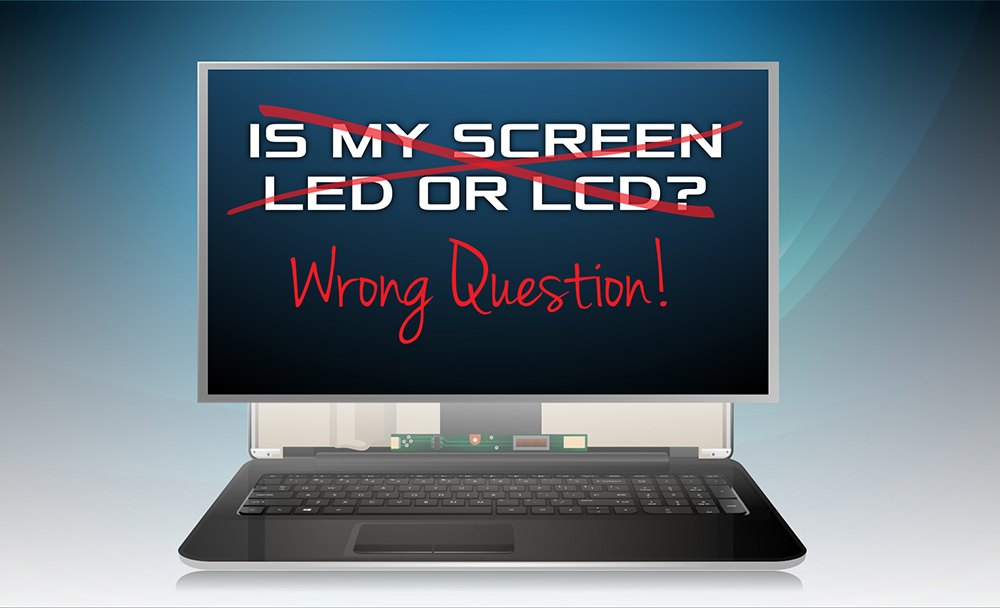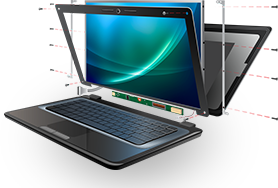“IS MY SCREEN LED OR LCD?” – is is an incorrect question; as all laptop screens are LCD screens, some of them are LED LCD screens and some are CCFL LCD screens.
Overwhelmingly all modern laptop screens are LCD – Liquid Crystal Display.
Liquid Crystals are like little shutters – they become transparent whenever some electricity is applied to them. So on an LCD matrix there are lots of “shutters” called pixels, that can open up to become either clear, red, green or blue.
Liquid Crystal technology requires a separate light source positioned behind the LCD Matrix (part that forms the image) to shine through the “shutters”.
Whenever you see or hear “LED screen”, it usually means an LCD panel with a backlighting provided by an array of LEDs (Light Emitting Diodes). Older screens use a CCFL (Cold Cathode Fluorescent Light) to light up the screen – same type of technology as office “tube” lights – just smaller; but the part that forms the image is still LCD.

There are some newer technologies like OLED (Organic Light Emitting Diodes) which combine the image forming and light production – every pixel on those screens produces it’s own light – but these screens are not used in laptops yet (mostly phones and now the smart watches).

LED backlit screens are more energy efficient and usually serve longer than CCFL. Most newer laptops and all brand-new laptops are made with LED backlit LCD panels. To learn more about various backlight types, and the difference between LED and CCFL, please refer to this post.
Copyright (©) LaptopScreen.com


Pingback: Blog.LaptopScreen.com
Pingback: Diagnosing backlight issues. | Blog.LaptopScreen.com
Pingback: Can a broken LCD screen be fixed without replacing? | Blog.LaptopScreen.com
When you have an article with this title, you ought to answer the question in the title by telling people how to determine which type of back lighting they have. You have an article doing that for resolution and screen size, why not back lighting?
We do have an article to help explain this. We have posted a link at the end of the article
“To learn more about various backlight types, and the difference between LED and CCFL, please refer to this post.”
Which links to the following article https://www.laptopscreen.com/blog/ordering-correct-lcd/
The main problem with backlight is that the technology is always improving making old styles obsolete. Resolution and screen sizes can still be determined the same today as it was many years ago.
Please can every laptop with LCD be replaced with LED screens? (Asus X551M)
This is not a correct type of question to ask. All screens today for laptops are LCD. LED simply refers to the backlight type. Older LCD screens used to have CCFL backlight but now current models of LCDs made have LED backlight.
Can i replace my ccfl backlight display with lED bbacklight one.. for my lenovo v130 laptop
The simple answer is no, they are not cross compatible as replacements. There are ways of modifying a screen or laptop to accept the different type of backlight type however it is more practical to buy a newer model with an LED backlit screen.
Please send a picture of it
Please confirm the question you are asking.
Hi,
I have a laptop and how can i indentify my laptos screen is LCD,LED or CCFL?
Hello,
Please provide your laptop model and we can assist.
Can I connect Normal LED Display insytead of Paper LED in Asus U30JC Laptops.
The LCDs we have listed will be compatible.
Can i replace my backlit LCD panel to an OLED panel? Asus vivobook x512f
There are no known OLED screens for this laptop model.
Did there used to be laptops with LED screens that were not LCD? Or were they always LCD as well? At one point about 10 years ago or so I had to get computers with a certain uncommon screen type that would not cause a problem with movement in my eye sight, I don’t remember what it was but am looking to find it again and I am now wondering if it could have been a technology that is no longer, or if I misunderstood what it was.
There was CCFL screens, that is likely what you are referring too. What we recommend is looking into “flicker free” screens.
I asked my colleague what he thought and it might be best for you to look into monitors rather than laptop screens.
He has provided a couple of links that will be of use:
https://tftcentral.co.uk/
https://tftcentral.co.uk/articles/flicker_free_database
Hello, thank you very much for the information in your article.
I am looking into buying a new lower-end Lenovo laptop for word processing mainly (i am a writter). What I notice in the tech specs on Lenovo’s website is that some models say the word ‘backlit’ in the specs defining the display (monitor), and specs for other models say nothing about the display being backlit. This initially lead me to believe some laptop displays are backlit and others are not backlit. But I also know this kind of thing could have been an unwitting omission by someone that is just putting together spec sheets, having no technical knowledge themselves. Hence me bouncing around the web until I rested on your article.
I am interested in the Lenovo Idea Pad 1i14 (#82LV003YUS), released April of 2022. In the specs posted for this model it states the display is a 14-inch FHD display, but does not say it is backlit like some of the others models do in the lower-end category of laptops available. But if I understand what you have said correctly, all laptop displays are backlit by something, and this being LEDs, *not CCFLs today*, correct? So it should not matter whether the word ‘backlit’ is mentioned as a feature in display specs or not, as any laptop monitor is backlit regardless, right?
The other thing I would like to know is if it is necessary to get a desktop monitor over a laptop monitor to avoid flicker, even though there are not flickering CCFLs in new laptop displays that I am considering purchasing today?
I am grateful for any help you can provide as currently those i have spoken with that are manning the phone lines at Lenovo’s Call Center do not know how to answer these questions.
Blessings, Gwin Goodwin
Hello,
It is essentially just a difference in the wording. All modern LCD’s will have a functioning backlight.